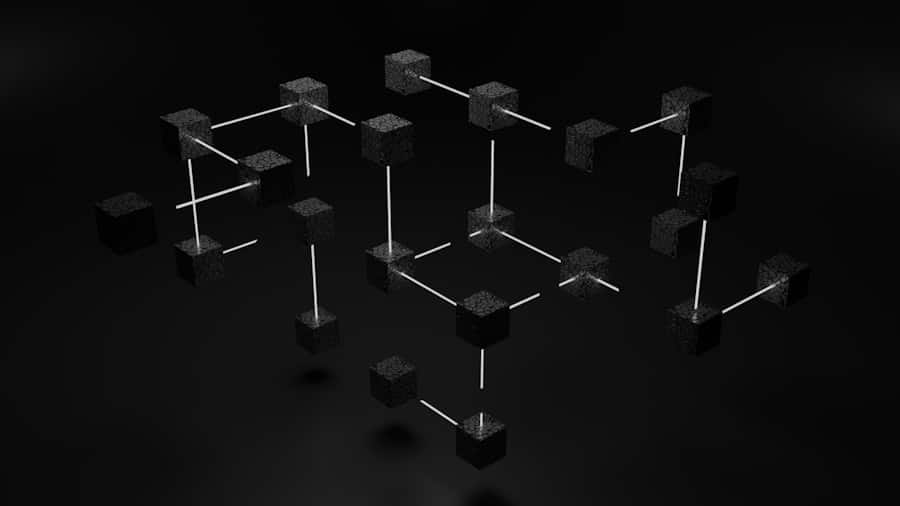Blockchain technology has emerged as a revolutionary force in the digital landscape, fundamentally altering how data is stored, shared, and secured. At its core, blockchain is a decentralized ledger that records transactions across multiple computers in such a way that the registered transactions cannot be altered retroactively. This inherent immutability, combined with cryptographic security measures, makes blockchain an attractive solution for addressing various cybersecurity challenges.
As organizations increasingly rely on digital infrastructures, the need for robust cybersecurity measures has never been more critical. The intersection of blockchain and cybersecurity presents a unique opportunity to enhance data integrity, confidentiality, and availability. The rise of cyber threats, including data breaches, identity theft, and ransomware attacks, has prompted businesses and governments to seek innovative solutions to safeguard sensitive information.
Traditional security measures often fall short in providing the necessary protection against sophisticated cybercriminals. Blockchain’s decentralized nature mitigates single points of failure, making it significantly more resilient against attacks. By distributing data across a network of nodes, blockchain ensures that even if one node is compromised, the integrity of the entire system remains intact.
This article delves into various applications of blockchain technology in enhancing cybersecurity, exploring its potential to secure identity management, data storage, transactions, supply chains, IoT devices, and voting systems.
Key Takeaways
- Blockchain technology can greatly enhance cybersecurity by providing secure and transparent data storage and transfer.
- Securing identity and access management with blockchain can prevent unauthorized access and identity theft.
- Implementing smart contracts for secure transactions can ensure that all parties involved fulfill their obligations without the need for intermediaries.
- Blockchain can enhance supply chain security by providing a transparent and immutable record of transactions and product movement.
- Protecting Internet of Things (IoT) devices with blockchain can prevent unauthorized access and tampering of connected devices.
Securing Identity and Access Management with Blockchain
Identity and access management (IAM) is a critical component of cybersecurity, as it governs how individuals gain access to systems and data. Traditional IAM systems often rely on centralized databases that are vulnerable to breaches and unauthorized access. Blockchain technology offers a decentralized alternative that enhances security and user control over personal information.
By utilizing blockchain for IAM, individuals can create self-sovereign identities that are not tied to any central authority. This means users have full control over their identity data and can selectively share it with trusted parties without exposing themselves to unnecessary risks. For instance, consider a scenario where an individual needs to verify their identity for online banking services.
Instead of providing sensitive information such as Social Security numbers or bank account details to multiple institutions, a user can leverage a blockchain-based identity solution. This system allows them to create a digital identity that is cryptographically secured and can be verified by banks without revealing the underlying data. The use of public-private key cryptography ensures that only authorized entities can access the information, significantly reducing the risk of identity theft and fraud.
Furthermore, blockchain’s transparency allows for real-time auditing of access logs, enabling organizations to monitor who accessed what information and when.
Using Blockchain for Secure Data Storage and Transfer

Data storage and transfer are fundamental aspects of modern computing, yet they are fraught with security vulnerabilities. Traditional storage solutions often rely on centralized servers that can be targeted by cybercriminals seeking to exploit weaknesses in security protocols. Blockchain technology provides a decentralized framework for secure data storage and transfer, ensuring that data remains intact and accessible only to authorized users.
By distributing data across a network of nodes, blockchain eliminates the risks associated with single points of failure while enhancing data integrity through cryptographic hashing. One compelling example of blockchain’s application in secure data storage is in the healthcare sector. Patient records are highly sensitive and must be protected from unauthorized access while remaining accessible to healthcare providers when needed.
A blockchain-based system can store patient data in encrypted form across multiple nodes, allowing healthcare professionals to access the information securely without compromising patient privacy. Additionally, patients can grant or revoke access to their medical records at any time, empowering them with control over their personal health information. This approach not only enhances security but also fosters trust between patients and healthcare providers.
Implementing Smart Contracts for Secure Transactions
Smart contracts are self-executing contracts with the terms of the agreement directly written into code on the blockchain. They automate processes and enforce agreements without the need for intermediaries, significantly reducing the risk of fraud and errors in transactions. By leveraging smart contracts, organizations can ensure that transactions are executed securely and transparently while minimizing the potential for disputes.
The immutable nature of blockchain ensures that once a smart contract is deployed, it cannot be altered or tampered with, providing an additional layer of security. A practical application of smart contracts can be seen in the real estate industry. Traditionally, property transactions involve numerous intermediaries such as real estate agents, lawyers, and banks, each adding complexity and potential points of failure to the process.
By utilizing smart contracts on a blockchain platform, buyers and sellers can execute transactions directly with one another. The smart contract can automatically verify conditions such as payment completion or title transfer before executing the transaction. This not only streamlines the process but also reduces costs associated with intermediaries while enhancing security through transparent record-keeping.
Enhancing Supply Chain Security with Blockchain
Supply chain management is another area where blockchain technology can significantly enhance security and transparency. The complexity of global supply chains often leads to vulnerabilities such as counterfeit products, fraud, and lack of traceability.
This level of transparency allows stakeholders to verify the authenticity of products and track their journey through the supply chain. For example, consider the food industry where traceability is crucial for ensuring food safety. In the event of a foodborne illness outbreak, being able to trace contaminated products back to their source quickly can save lives and prevent widespread panic.
A blockchain-based supply chain solution enables each participant—from farmers to distributors—to record relevant information about the product at each stage of its journey. If an issue arises, stakeholders can quickly identify the source of contamination and take appropriate action. This not only enhances consumer safety but also builds trust among consumers who are increasingly concerned about the origins of their food.
Protecting Internet of Things (IoT) Devices with Blockchain

The proliferation of Internet of Things (IoT) devices has transformed how we interact with technology; however, it has also introduced new cybersecurity challenges. Many IoT devices lack robust security measures, making them susceptible to hacking and exploitation. Blockchain technology offers a promising solution by providing a secure framework for managing IoT devices and their data exchanges.
By leveraging decentralized networks, organizations can enhance the security of IoT ecosystems while ensuring that devices communicate securely. One notable application is in smart home devices such as thermostats, security cameras, and appliances. These devices often communicate over unsecured networks, making them prime targets for cybercriminals seeking unauthorized access or control.
By integrating blockchain into IoT systems, each device can have its unique identity on the blockchain, allowing for secure authentication and communication between devices. For instance, if a smart thermostat needs to communicate with a smart security camera to adjust settings based on occupancy detection, this interaction can occur securely through blockchain protocols that verify device identities before allowing data exchange.
Leveraging Blockchain for Secure Voting Systems
The integrity of voting systems is paramount in democratic societies; however, traditional voting methods are often vulnerable to manipulation and fraud. Blockchain technology presents an innovative approach to secure voting by providing a transparent and tamper-proof record of votes cast during elections. By utilizing blockchain for voting systems, governments can enhance voter confidence while ensuring that election results are accurate and verifiable.
In practice, a blockchain-based voting system allows voters to cast their ballots securely from their devices while maintaining anonymity through cryptographic techniques. Each vote is recorded on the blockchain as a transaction that cannot be altered or deleted once confirmed. This creates an immutable record that can be audited by independent parties to verify election outcomes without compromising voter privacy.
Future Trends and Challenges in Blockchain Cybersecurity
As blockchain technology continues to evolve, several trends are emerging that will shape its role in cybersecurity over the coming years. One significant trend is the increasing integration of artificial intelligence (AI) with blockchain solutions. AI can enhance threat detection capabilities by analyzing vast amounts of data generated within blockchain networks to identify anomalies or potential security breaches in real-time.
This synergy between AI and blockchain could lead to more proactive cybersecurity measures that adapt dynamically to emerging threats. However, despite its potential benefits, several challenges remain in implementing blockchain for cybersecurity purposes. Scalability is one major concern; as more transactions are added to a blockchain network, performance may degrade due to increased processing requirements.
Additionally, regulatory compliance poses another challenge as governments grapple with how best to regulate decentralized technologies without stifling innovation. Ensuring interoperability between different blockchain platforms is also crucial for widespread adoption; without standardization across networks, organizations may face difficulties in integrating blockchain solutions into existing systems. In conclusion, while blockchain technology offers promising solutions for enhancing cybersecurity across various domains—from identity management to secure voting systems—its successful implementation will require addressing these challenges head-on through collaboration among industry stakeholders, regulators, and technologists alike.
A related article to How Blockchain is Being Used in Cybersecurity is “CNET Tracks All the Latest Consumer Technology Breakthroughs.” This article discusses the latest advancements in consumer technology and how they are impacting our daily lives. To read more about the latest breakthroughs in consumer technology, check out the article here.
FAQs
What is blockchain technology?
Blockchain technology is a decentralized, distributed ledger that records transactions across many computers in such a way that the registered transactions cannot be altered retroactively.
How is blockchain being used in cybersecurity?
Blockchain is being used in cybersecurity to provide secure and tamper-proof storage of data, authentication of users, and protection against unauthorized access and data breaches.
What are the benefits of using blockchain in cybersecurity?
The benefits of using blockchain in cybersecurity include increased data security, transparency, and immutability, as well as reduced risk of data tampering and unauthorized access.
What are some examples of blockchain applications in cybersecurity?
Some examples of blockchain applications in cybersecurity include secure storage of sensitive data, authentication and access control systems, and secure communication and messaging platforms.
How does blockchain technology enhance data security?
Blockchain technology enhances data security by providing a decentralized and tamper-proof ledger that ensures the integrity and authenticity of data, making it difficult for hackers to alter or manipulate the data.
Is blockchain technology completely secure for cybersecurity purposes?
While blockchain technology offers enhanced security features, it is not completely immune to security threats. It is important to implement additional cybersecurity measures in conjunction with blockchain technology to ensure comprehensive protection.

